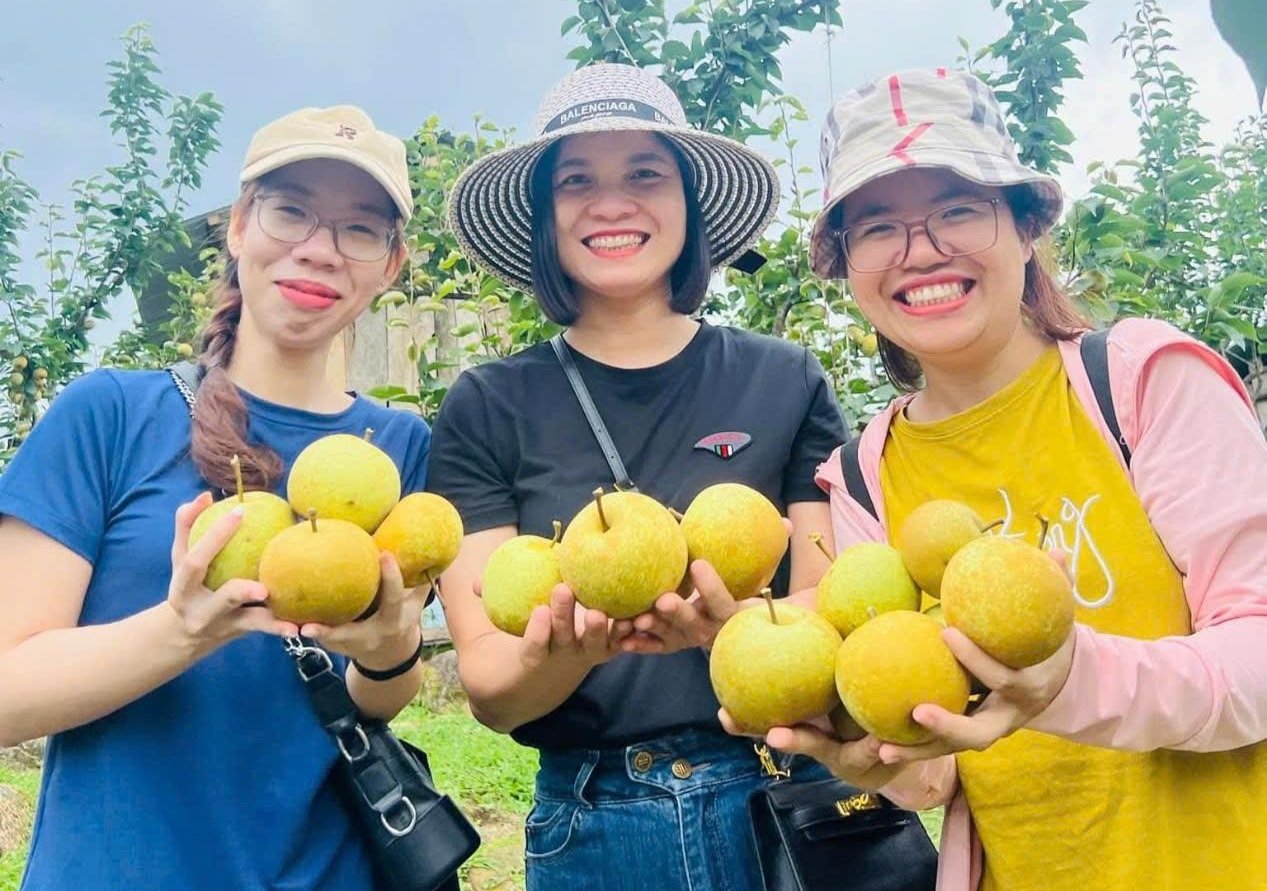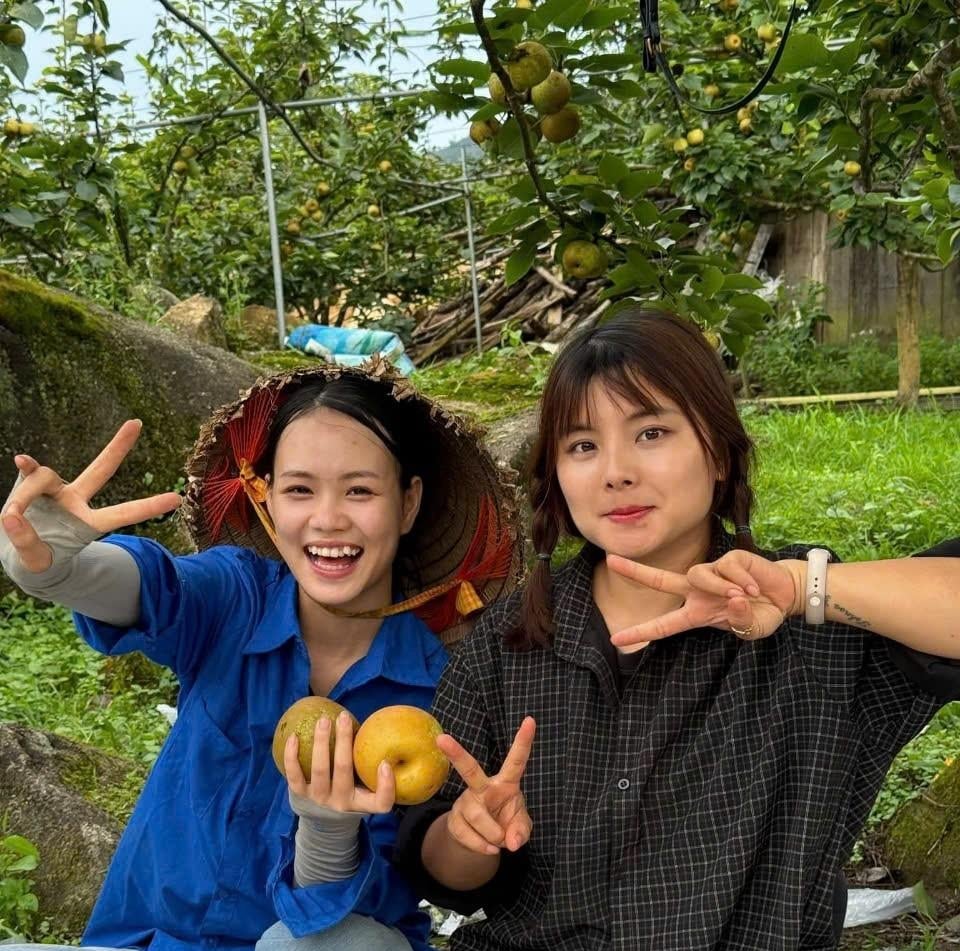November 28, 2025 | 15:38 GMT +7
November 28, 2025 | 15:38 GMT +7
Hotline: 0913.378.918
November 28, 2025 | 15:38 GMT +7
Hotline: 0913.378.918
Every July, the VH6 pear orchards across communes such as Nam Pung (former Bat Xat district), Y Ty, as well as Hoang Thu Pho, Ban Gia, Lau Thi Ngai, Thai Giang Pho, Ta Chai, Na Hoi, Ban Pho, Ta Van Chu (former Bac Ha district), and Ta Ngai Cho, Lung Khau Nhin, Cao Son (former Muong Khuong district) enter their harvest season.

Visitors enjoy picking pears and taking photos right in the orchard in Nam Pung (former Bat Xat district). Photo: Luu Hoa.
The round, plump pears with sweet, refreshing, and juicy flavor are nurtured by the year-round cool climate and fertile soil of the highlands, together with the careful tending of local farmers. Cultivated organically without chemicals, the pear orchards of Lao Cai are renowned for their high yields and superior quality. With farm-gate prices ranging from 30,000 to 70,000 VND per kilogram, the VH6 pear has become the main source of income for many households, contributing to sustainable poverty reduction.
More than just a key agricultural product, the VH6 pear has now opened a new direction for experiential agricultural tourism in the Lao Cai highlands.
Every harvest season, the pear orchards become a standout destination, attracting thousands of visitors. Tourists come to experience walking along winding paths amid lush green pear hills, visiting ethnic minority villages, savoring flavorful local cuisine, and, most importantly, picking pears themselves while listening to farmers share stories about highland farming, harvest seasons, and the surrounding mountains and forests. Visitors not only gain a deeper understanding of pear cultivation and care processes but can also pick and enjoy fresh, delicious pears right in the orchard.

Ha Nhi people in former Bat Xat pick plump, juicy pears to offer visitors. Photo: Luu Hoa.
Unlike previous years, when the pear hills were still pristine with only a few villagers quietly harvesting fruit, the atmosphere has now completely changed. Instead of just picking pears to sell at the market, locals now set up small stalls right on the hills. A simple tarpaulin for shade, a few baskets full of pears, and a bamboo board neatly inscribed with the words: Homegrown pears - Free tasting.
A Ha Nhi woman in Y Ty, while rearranging baskets of pears, smiled and said: "In the past, we only earned a few dozen thousand dong at the market each day, but now we can make up to a million. We are not just selling pears anymore, we’re also selling the scenery and our own stories."
A young visitor from Hanoi, experiencing Bac Ha for the first time, excitedly shared: "I thought it would just be about picking some fruit and going home. But on the hill, I got to taste crispy, sweet pears on the spot, hear locals talk about planting trees and preserving the land, and was even invited to drink herbal tea from forest leaves."
Lao Cai’s agriculture is taking positive steps, gradually affirming its position and development potential. Building an agricultural model combined with tourism enhances the value of local produce and creates jobs for the community.

Visitors enjoy taking photos at the pear orchard. Photo: Luu Hoa.
Accommodation and culinary services have also proliferated, offering visitors a peaceful retreat amid pristine nature and vast stretches of pear orchards. Each pear harvest season, Lao Cai seems to put on a new coat, full of color and vitality. With just one trip here, travelers can feel the fresh air, taste the sweet flavor of the pears, and share in the joy of local people as they see their produce recognized and appreciated far and wide.
Children in the village have also changed. They are no longer shy, they now know how to greet visitors and run to call their mothers when someone wants to buy pears or take photos. Many families have even set up small stalls to sell honey, brocade, and mountain-grown vegetables, creating an entire agricultural tourism experience space right in the midst of nature.
No longer needing to leave their homeland to make a living, local people can now welcome visitors among their pear and plum orchards, sell products made by their own hands, and proudly share stories about their native mountains and forests.
Translated by Kieu Chi

(VAN) On November 28, in Beijing, Minister Tran Duc Thang met Minister of Ecology and Environment of China Huang Runqiu, to share experience on environmental protection.
/2025/11/28/0950-2-120557_751.jpg)
(VAN) The recent flood spell in the South Central region clearly reflects the characteristics of natural disasters in 2025, which are compound, prolonged, and amplified.

(VAN) Farmers in Lam Dong are shifting to green dragon fruit production and moving toward sustainable agriculture.

(VAN) Over 80 years, Vietnam’s forestry sector has raised national forest cover, advanced the green economy, and strengthened sustainable development.

(VAN) The European business community is committed to a long-term partnership with Vietnam in sustainable development and promoting the circular economy.

(VAN) As the flood season arrives, Dong Thap farmers on the upstream fence off fields to store wild fish, maintaining resource abundance and livelihoods.

(VAN) On November 27, in the meeting with Minister Tran Duc Thang, Mayor Yin Yong shared Beijing’s experience to improve environment and air quality.